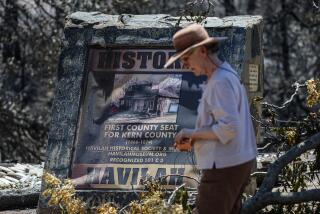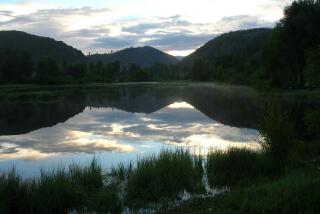In Virginia City, a lode of Comstock lore
Virginia City, Nev. â In this 6,200-foot-high Sierra town, the streets tumble down a mountainside punctuated by mounds of rusting mine tailings and wood-and-brick buildings, relics of an era past.
FOR THE RECORD:
An article in the Aug. 31 Travel section about Virginia City (âIn Virginia City, a Lode of Comstock Lore,â Weekend Escape) incorrectly reported that rare woods used in an 1868 mansion were shipped around the Horn of Africa. They were shipped around Cape Horn, at the tip of South America.
From 1865 and for the next 20 or so years, folks made rich by the Comstock Lode lived at the top of the hill, along A and B streets. C Street was the commercial heart of the city, and below that, on D, was the red-light district. Chinatown was lower still, on H Street, surrounded by the tiny cabins of mining families whose men searched for silver and occasionally gold in the honeycomb of tunnels descending nearly 3,000 feet.
As a child, I often heard my grandfatherâs stories of Virginia City: the fabulous wealth of the Comstock and its colorful cast of dreamers and cheats â men who came to the rocky, silver-laden slopes of Mt. Davidson with a dollar in their pockets and walked away with millions.
Although I had made one brief stop here a few years ago, I never had explored it. So on a weekend in May, joined by my parents, Royal and Bobbe, I made the trip again.
Visitors can fly to Carson City, about 15 miles southwest, or to Reno, about 25 miles north. But we chose to drive, a trip of about 450 miles from L.A.
We stayed at the historic Gold Hill Hotel, built in 1859 and still full of Old West atmosphere. Gold Hill, a mile down the road from Virginia City, had been a boomtown in its own right. The hotel is perched on a hill in front of the Yellow Jacket Mine elevator shaft, and its location and décor are reminders of yesteryear.
Our room had carved wood beds, a Victorian dresser and reputedly the ghost of a child â too shy to put in an appearance while we were there. Echoes of the mining past were downstairs in the form of the parlorâs original low ceiling, stone fireplace and rocking chair.
After a fine dinner â Caesar salad tossed at our table, chicken piccata (one of three entrees on that nightâs menu) and cherry vanilla ice cream â we were ushered from the hotel dining room back into the parlor, which had been rearranged as a theater. The Gold Hill Theater Troupe presented a rousing melodrama, âRansom and Revenge in Chinatown,â based on happenings in Virginia City in the 1880s. We had great fun hissing at the villain and applauding the hero, just like the good old days.
The next morning we started our exploration of Virginia City, which at its peak in the 1870s had a population of about 30,000, compared with 800 today.
At the top of Millionaireâs Row on B Street still stands the 1868 mansion called the Castle. Built by engineer turned millionaire Robert Graves, this wooden mansion with a castle-like turret and lilac-filled garden is remarkable, partly because it contains the original furnishings, including wallpaper, carpet and Belgian lace curtains, which our guide said cost $3,000 a panel when the home was built â or about $37,000 today, adjusted for inflation.
The guide also pointed out the rare woods that had been shipped around the Horn of Africa for paneling and balustrades, the Bohemian cut crystal chandeliers in the double parlors and a breathtaking red-and-white swirled glass lamp that is one of only two of its kind known to exist. The doorknobs and carpet braces up the stairs are solid silver. The most fascinating thing to me was the original French wallpaper, fashioned from gold and silver leaf that gleamed in the sunlight with an iridescent bird design.
One of the few faults of this house: no bathrooms. Chamber pots had been tucked into all of the nightstands.
That wasnât the case at the townâs other well-preserved estate, the Mackay Mansion, built in 1860 with running water and a full bathroom.
John Mackay used the mansion as a home and the headquarters for his mining company. Mackay was born in Ireland and grew up fatherless and penniless on the streets of New York. He headed west during the Gold Rush of 1849 and supposedly ended up as one of the richest men in America by the late 1870s.
He built his mansion on the lip of the great pit where miners worked 1,000 feet below, 24 hours a day. According to our guide, the wraparound balconies of the house were built so Mackay could oversee workersâ progress.
Mackayâs wife, Louise, was less interested in the mining of gold and silver than she was in the spending of it. She sent boxes of bullion to Tiffany in New York to have it fashioned into chandeliers, serving pieces and cutlery, each solid silver piece inlaid with gold.
We stopped for a lunch of chili and hamburgers at the Palace Restaurant and Saloon on C Street. According to local newspapers of the 1870s, residents were crazy about oysters. Alas, theyâre no longer on the menu.
Across the street, mine shaft entrances lie below the buildings. The Bonanza Saloon, where we had lunch the next day, runs tours through its subterranean maze, part of an estimated 350 to 750 miles of tunnels beneath Virginia City.
After lunch we headed for the Chollar Mine, the only major mine on the Comstock Lode open for viewing. According to our guide, of the 11,000 mining claims filed in the area during its heyday, only 30 paid off and just five hit it big. The Chollar Mine was the fifth richest claim on the Comstock.
As we followed the guide single-file down the mine, daylight vanished and the air turned cool. We had to double over to avoid cracking our heads on the great square timbers that held up the mountain above. A canvas hose pumped in air, but the floor was still slippery with mud.
After what seemed like ages, we reached the ore face, where silver flecks glittered in the wall. By candlelight, our guide showed us how, before the 1867 invention of dynamite, miners used hammers and iron spikes to break away the rock.
Although they were relegated to the lower levels of Virginia City geographically and socially, Chinese residents played a significant part in its development. They sold much-sought-after wood, operated most of the laundries and helped build the Virginia and Truckee Railroad, which delivered ore to Carson City.
Today the Mandarin Garden Chinese Restaurant operates on the second floor of the old Knights of Pythias Hall, part of a row of brick buildings on North B Street put up after the catastrophic 1875 fire that burned nearly the whole town. We enjoyed honey crispy walnut chicken, kung pao pork and Mongolian beef under the buildingâs original stamped tin ceiling.
The opera lives on
Not far away on C Street, Mark Twain worked as a reporter for the Territorial Enterprise, whose offices have been turned into a museum dedicated to Twain. Down the block at 111 S. C St. is Mark Twainâs Bookstore, which carries a nice selection on the Comstock as well as an impressive collection of old photographs and memorabilia.From busy C Street we climbed the short, steep hill to B Street for a tour of Piperâs Opera House, which stands near the elegant yellow-and-white Victorian facade of the Storey County Courthouse. The opera house was built in 1885 and went on to host a variety of acts, including actors Lillie Langtry and John Barrymore and vaudeville comedian Eddie Foy.
The theater is in the middle of a $7-million renovation, but the show does go on. Our visit was sandwiched between an original opera and a performance by the Nevada Ballet Society.
In Virginia Cityâs glory days, most everything built was of the highest quality because the town had so much money.
The Fourth Ward School at the south end of C Street is a four-story, red-and-white Second Empire-style landmark constructed a year after the 1875 fire and restored to its original beauty as a museum. It has to be one of the fanciest schoolhouses erected in the U.S. in the 19th century.
Large, airy rooms were built of chevron-patterned pine and had extremely high ceilings that kept students cool. Desks had attached seats and inkwells â a state-of-the-art design for the time. Drinking fountains and flush toilets were luxuries for the pampered students, most of whose fathers worked in the mines for the monumental wage of $4 a day.
Several of the classrooms have been outfitted to look as they did in the 1870s, and on my visit, the place once again was filled with the sounds of children, thanks to a touring school group.
Back at the hotel, downstairs in the parlor, the empty rocking chair was swaying gently in front of the fireplace. Maybe our ghost had come to call after all.
Budget for three
Expenses for this trip:
Gold Hill Hotel Two nights, with tax $187.00
AdmissionThe Castle $13.50
Admission Mackay Mansion $12.00
Lunch Palace Restaurant $28.00
Dinner and play Gold Hill Hotel $75.00
Lunch Bonanza Saloon $24.00
Admission Chollar Mine $15.00
Dinner Mandarin Garden $49.16
Gas $74.80
Final tab $478.46
CONTACT: Gold Hill Hotel, 1540 S. Main St. (Highway 342), Gold Hill, NV 89440; (775) 847-0111, fax (775) 847-0604, www.goldhillhotel.net.
More to Read
Sign up for The Wild
Weâll help you find the best places to hike, bike and run, as well as the perfect silent spots for meditation and yoga.
You may occasionally receive promotional content from the Los Angeles Times.






